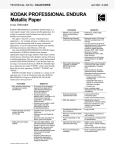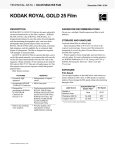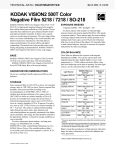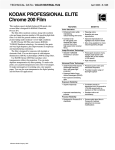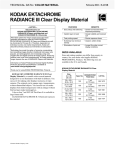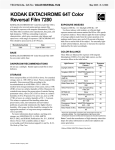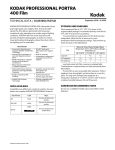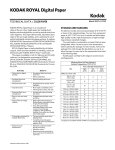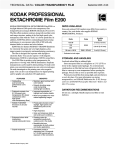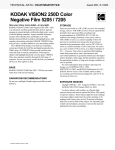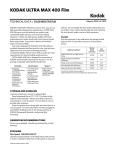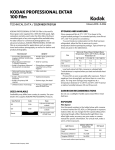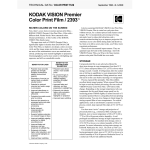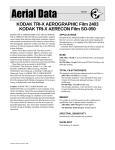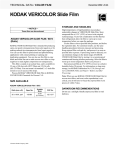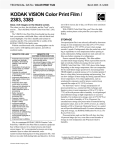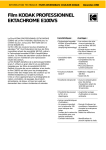Download Kodak E-142 User's Manual
Transcript
January 2003 • E-142 TECHNICAL DATA / COLOR PAPER KODAK PROFESSIONAL ULTRA III Paper FEATURES —NOTICE— KODAK PROFESSIONAL ULTRA ENDURA Paper replaces KODAK PROFESSIONAL ULTRA III Paper. ULTRA ENDURA Paper also provides an alternative to KODAK PROFESSIONAL Digital III Color Paper KODAK PROFESSIONAL ULTRA III Paper is a fast, resin-coated multilayer paper for optical printing of color negatives or internegatives. It provides the higher contrast needed for such commercial applications as point-of-purchase and trade-show materials and large display prints. It offers consistent, high-quality output for greater productivity and less waste. It is optimized for commercial applications and is designed for printing with automatic printers or enlargers. Use KODAK EKTACOLOR RA Chemicals for Process RA-4 to process this paper. This paper replaces KODAK EKTACOLOR ULTRA II Paper. It is available in sheets and rolls in F (glossy), E (fine lustre), and N (smooth lustre) surfaces. ULTRA III Paper incorporates a number of technical improvements. It provides higher color saturation and more accurate colors than EKTACOLOR ULTRA II Paper. Labs will benefit from its improved latent-image keeping, reduced heat sensitivity, and excellent print consistency due to improved reciprocity. Compared to EKTACOLOR ULTRA II Paper, this paper offers these features: FEATURES • Improved color reproduction • Improved highlight reproduction BENEFITS • More accurate reds, greens, and magentas • Brighter blues and cyans • More saturated yellows • Truer reproduction of high-key scenes • Cleaner highlights • Improved shadow rendition • More retention of detail in shadows • Excellent reciprocity characteristics • Easier matching of color balance and saturation in prints regardless of the degree of enlargement • Improved first-print yield from under- and overexposed negatives • Easier dodging and burning • Faster red printing speed • Higher productivity for enlargements ©Eastman Kodak Company, 2001 BENEFITS • Excellent latent-image • Improved processing keeping from 1 minute to consistency in the lab 24 hours • Optimized spectral sensitivity • Better alignment between paper, film dyes, video analyzer, and printer spectral response • Improved printing compatibility and image quality with KODAK PROFESSIONAL Films • Elimination of print-out and thermal yellowing • Longer print life under dark storage conditions STORAGE AND HANDLING Store unexposed paper at 13°C (55°F) or lower in the original sealed package. High temperatures or high humidity may produce unwanted quality changes. To avoid moisture condensation on paper that has been refrigerated, allow it to warm up to room temperature before opening the package. For best results, remove the paper from cold storage the day before you use it, or allow the paper to warm up for the appropriate time from the following table. Warm-Up Times (Hours) to Reach Room Temperature of 21°C (70°F) From a Storage Temperature of Size –18°C (0°F) 2°C (35°F) 13°C (55°F) 8 x 10-inch (100-sheet box) 4 3 2 16 x 20-inch (50-sheet box) 3 2 2 20 x 24-inch (50-sheet box) 3 2 2 8-inch x 575-foot roll 10 7 4 30-inch x 100-foot roll 8 6 4 40-inch x 100-foot roll 9 7 5 Handle paper carefully by the edges. The paper is packaged with the emulsion side of all sheets facing in the same direction. For complete light and moisture protection, use the inner bag and the two-part cardboard box to store the paper. DARKROOM RECOMMENDATIONS Handle this paper in total darkness. Be sure that your darkroom is lighttight. Eliminate stray light from enlarger heads, timers, LEDs, etc. Note: Using a safelight will affect your results. If absolutely necessary, you can use a safelight equipped with a KODAK 13 Safelight Filter (amber) with a 71⁄ 2 -watt bulb. Keep the safelight at least 4 feet (1.2 metres) from the paper. Run tests to determine that safelight use gives acceptable results for your application. 4. Then judge the color balance. You can use the KODAK Color Print Viewing Filter Kit, KODAK Publication No. R-25, to evaluate your test print. The kit contains 18 color-print viewing filters and instructions to help you determine filter adjustments for the white-light exposure method. If your print is Subtract these filters CYAN Magenta + Yellow (Red) Cyan MAGENTA Cyan + Yellow (Green) Magenta YELLOW Magenta + Cyan (Blue) Yellow RED Cyan Magenta + Yellow GREEN Magenta Cyan + Yellow BLUE Yellow Cyan + Magenta EXPOSURE Printing Equipment Expose this paper in automatic printers or enlargers equipped with tungsten or tungsten-halogen light sources or photo enlarger lamps (e.g., No. 212 or 302). Set up and balance the printer or enlarger according to the manufacturer’s instructions. Do not use fluorescent lamps to expose this paper. Use a heat-absorbing glass to remove infrared radiation. Because voltage changes affect light output and color quality, use a voltage regulator. Keep negatives and the equipment optical system clean. Mask negatives to eliminate stray light. You can use the white-light or the tricolor exposure method. White-Light Exposure Method Control color balance with dichroic filters built into the printer or enlarger, or with KODAK Color Printing (CP) Filters (Acetate) placed between the lamp and the negative. You can use any number of filters between the light source and the negative. If you use cyan filtration, use filters with the suffix “-2” (e.g., “CP10C-2”). 1. Start with a filter pack of 50M + 70Y to make a test print. OR Add these filters 5. Remove neutral density from your filter pack. For example, if you determine that a filter pack of 40R + 10Y + 10C will give you a pleasing print: a. Convert any primary filters (R, G, B) to their subtractive equivalents (C, M, Y): 40R = 40M + 40Y. b. Add filters of the same color: 10Y + 40Y = 50Y. c. If the new filter pack has all three subtractive colors, cancel the neutral density by subtracting the smallest density value from all three densities: 10C –10 40M –10 30M 50Y –10 40Y = filtration without neutral density 2. Evaluate the test print under light of the same color and brightness that you will use to display the final print. (See “Viewing”.) 3. Judge print density first. If necessary, make another print by adjusting the exposure as recommended in the table below: If your print is TOO LIGHT Do this Open the lens aperture to increase the light level Close the lens aperture to TOO DARK decrease the light level 2 OR Do this Increase the exposure time Decrease the exposure time KODAK PROFESSIONAL ULTRA III Paper • E-142 6. Adjust the exposure for the new filter pack. An exposure time that produced a print of satisfactory density may not produce an acceptable density when you change the filter pack. The following table gives filter factors for calculating exposure adjustments when you use KODAK CP or CC Filters. Tricolor Exposure Method Use KODAK WRATTEN Gelatin Filters No. 25 (red), No. 99 (green), and No. 47B (blue) to give the paper three separate exposures. Do not move the paper or the enlarger until you have made all three exposures. Typical exposure times for making an enlargement from a normally exposed negative are given in the table below. Filter Factors for CP Filters Times for an Aperture Setting of f/8* for PROFESSIONAL ULTRA III Paper (6X Enlargement of a KODAK VERICOLOR III Professional Film Negative) Filter Factor Filter Factor 05Y 1.1 05R 1.2 10Y 1.1 10R 1.3 20Y 1.1 20R 1.5 Red 21.8 seconds 17.5 seconds Filter 3 seconds 30Y 1.1 30R 1.7 Green 40Y 1.1 40R 1.9 Blue * For an enlarger equipped with a Photo Enlarger Lamp No. 212 or No. 302; the setting may vary with other types of lamps. 50Y 1.1 50R 2.2 05M 1.2 05G 1.1 10M 1.3 10G 1.2 20M 1.5 20G 1.3 30M 1.7 30G 1.4 40M 1.9 40G 1.5 50M 2.1 50G 1.7 05C 1.1 05B 1.1 10C 1.2 10B 1.3 20C 1.3 20B 1.6 30C 1.4 30B 2.0 40C 1.5 40B 2.4 50C 1.6 50B 2.9 To use the factors, divide the old exposure time by the factor for any filter you remove. If you add a filter, multiply the time by the factor. If you add or remove two or more filters, multiply the individual factors and use the result as your factor. You may need to modify these factors for your equipment. Note: The filter factors listed in the table take into account the effects of filter surfaces. When you adjust the filtration in equipment that has built-in dichroic filters, any noticeable differences in density are due to differences in the color density of the print. Suppose you have a print with acceptable density, but a magenta balance. When you add magenta filtration to correct the color balance, the print will become too light, so you must use a longer exposure time. A rule of thumb for magenta dichroic filtration is to change the exposure time by one percent for every unit of change in filtration. For example, if you increase the magenta filtration by 20M, increase the exposure time by 20 percent. Changes in yellow dichroic filtration do not usually affect the apparent print density. If you use cyan dichroic filtration, use the filter factors in the table above as starting points for adjusting exposure. KODAK PROFESSIONAL ULTRA III Paper • E-142 Evaluate the test print under light of the same color and brightness that you will use to display the final print. (See “Viewing”.) Judge the print density first. If necessary, make another print by adjusting the exposure as recommended in the table below. If your print is Do this TOO LIGHT Open the lens aperture to increase the light level OR Do this Increase all exposure times proportionately TOO DARK Close the lens aperture to decrease the light level Decrease all exposure times proportionately Then judge color balance. If your print is CYAN MAGENTA YELLOW RED GREEN BLUE Subtract time from the exposure through these filters OR Add time to the exposure through these filters Red Blue + Green Green Red + Blue Blue Red + Green Blue + Green Red Red + Blue Green Red + Green Blue 3 LATENT-IMAGE KEEPING RETOUCHING This paper features improvements in the stability of the latent image. Under normal conditions, you should not notice shifts in the latent image with keeping times from 1 minute to 24 hours. Therefore, you do not need to change your printing procedures to compensate for latent-image shifts under normal temperature and handling conditions. (If shifts do occur, you can minimize them by keeping the time between exposure and processing the same for all paper.) If possible, do any required retouching on color negatives before you make prints—especially if you plan to make more than one print from each negative. For information on retouching negatives, see KODAK Publication No. E-71, Retouching Color Negatives. If the negative image is small, you can make corrections much more easily by applying dry or liquid dyes to small or large areas of the enlarged print. Although you’ll probably do most retouching with dyes, you may sometimes want to use black lead, colored pencils, or opaque. Because color prints have separate dye layers, you can’t use an etching knife to reduce density as you can with black-and-white materials. For information on retouching prints, see KODAK Publication No. E-70, Retouching Prints on KODAK EKTACOLOR and EKTACHROME Papers. For information on lacquering and other post-process treatments, see KODAK Publication No. E-176, Post-Processing Treatment of Color Prints—Effects on Image Stability, available through our website at www.kodak.com/go/professional. PROCESSING Use KODAK EKTACOLOR RA Chemicals for Process RA-4 to process this paper. For information on processing this paper in continuous or roller-transport processors, see KODAK Publication No. Z-130, Using KODAK EKTACOLOR RA Chemicals. For information on processing this paper in trays or rotary-tube and drum processors, see KODAK Publication No. J-39, Tray, Drum, and Rotary-Tube Processing with KODAK EKTACOLOR RA Chemicals. Both publications are available through our website at www.kodak.com/go/photochemicals. Use a drying temperature below 205°F (96°C). Do not ferrotype this paper; the F surface dries to a natural gloss without ferrotyping. VIEWING Evaluate prints under light of the same color and brightness that you will use to view the final prints. A good average viewing condition is a light source with a color temperature of 5000 ± 1000 K, a Color Rendering Index (CRI) of 85 to 100, and an illuminance of at least 50 footcandles (538 lux). Fluorescent lamps such as the cool white deluxe (made by several manufacturers) meet these conditions. You can also use warmer lamps such as the Phillips 5000 K Ultralume, or a mixture of incandescent and fluorescent lamps. For each pair of 40-watt cool white deluxe fluorescent lamps, use a 75-watt frosted tungsten bulb. MOUNTING You can mount prints with KODAK Dry Mounting Tissue, Type 2. The temperature across the heating platen of the mounting press should be between 180 and 200°F (82 and 93°C). Temperatures above 210°F (99°C) or high pressure may cause physical and color changes in prints. Preheat the cover sheet that you use over the face of the print to remove moisture. Apply pressure for 30 seconds or longer for a thick mount. You can also use a contact-type adhesive or cement for cold-mounting. DISPLAYING Photographic dyes, like all dyes, can change with time and exposure to sunlight, ultraviolet radiation, excessive heat, and high humidity. To help prevent changes in photographic dyes, follow these guidelines: • Illuminate prints with tungsten light whenever possible. • Display prints in the lowest light level consistent with your viewing needs. • If a print is exposed to direct or indirect sunlight or fluorescent light, use an ultraviolet-absorbing filter (such as glass) between the light source and the print. • Keep the temperature and humidity as low as possible. 4 KODAK PROFESSIONAL ULTRA III Paper • E-142 SIZES AVAILABLE KODAK PROFESSIONAL ULTRA III Paper is available in a variety of roll and sheet sizes. Sizes and catalog numbers may differ from country to country. See your dealer who supplies KODAK PROFESSIONAL Products. Rolls in. x ft Rolls cm x m Surface Spec No. CAT No. 5 x 577 12.7 x 176 F 224 171 5507 8 x 577 20.3 x 176 F 224 193 9537 8 x 577 20.3 x 176 N 224 811 1478 10 x 288 25.4 x 88 F 224 815 6493 Size in. x in. Size cm x cm Sheets Per Package 10 x 288 25.4 x 88 N 224 820 0230 Surface CAT No. 11 x 288 27.9 x 88 F 224 828 3111 8 x 10 20.3 x 25.4 F 100 848 5260 11 x 288 27.9 x 88 N 224 840 0657 8 x 10 20.3 x 25.4 N 100 181 1306 20 x 288 50.8 x 88 N 223 829 4811 50.8 x 88 E 224 875 9409 224 183 9166 81⁄ 2x 11 21.6 x 27.9 F 50 175 2724 20 x 288 81⁄ 2x 11 21.6 x 27.9 N 50 801 0944 20 x 288 50.8 x 88 F 25.4 x 25.4 N 50 873 3099 20 x 288 50.8 x 88 N 224 858 0052 76.2 x 50 F 223 884 5075 10 x 10 11 x 14 27.9 x 35.6 F 50 876 2155 30 x 164 11 x 14 27.9 x 35.6 N 50 899 6191 30 x 164 76.2 x 50 N 223 893 8300 16 x 20 40.6 x 50.8 F 50 843 6644 40 x 164 101.6 x 50 N 223 175 6626 127 x 50 F 223 883 9003 16 x 20 40.6 x 50.8 N 50 875 1448 50 x 164 20 x 24 50.8 x 61 F 50 807 3983 50 x 164 127 x 50 N 223 889 5054 834 1919 72 x 100 182.9 x 30 N 223 854 9545 20 x 24 50.8 x 61 N 50 30 x 40 76.2 x 101.6 F 25 179 2720 30 x 40 76.2 x 101.6 N 50 194 2953 KODAK PROFESSIONAL ULTRA III Paper • E-142 5 CURVES Spectral-Dye-Density Curves Characteristic Curves 2.5 4.0 Process: RA-4 Exposure: 0.5 sec Process: RA-4, 95°F(35°C) 45 sec Densitometry: Status A DENSITY DIFFUSE SPECTRAL DENSITY 2.0 3.0 B G R 2.0 1.0 1.5 Cyan Yellow Magenta 1.0 0.5 0.0 0.0 3.0 2.0 0.0 1.0 400 1.0 500 F002_0341AC F002_0967AC LOG EXPOSURE (lux-seconds) 600 700 WAVELENGTH (nm) Spectral-Sensitivity Curves 2.0 Effective Exposure: 0.5 sec Process: RA-4 YellowForming Layer LOG SENSITIVITY * 1.0 MagentaForming Layer 0.0 1.0 CyanForming Layer 2.0 250 300 350 400 450 500 550 600 650 700 750 WAVELENGTH (nm) 2 *Sensitivity = reciprocal of exposure (ergs/cm ) required to produce specified density F002_0340AC NOTICE: The sensitometric curves and data in this publication represent product tested under the conditions of exposure and processing specified. They are representative of production coatings, and therefore do not apply directly to a particular box or roll of photographic material. They do not represent standards or specifications that must be met by Eastman Kodak Company. The company reserves the right to change and improve product characteristics at any time. 6 KODAK PROFESSIONAL ULTRA III Paper • E-142 MORE INFORMATION Kodak has many publications to assist you with information on Kodak products, equipment, and materials. Additional information is available on the Kodak website and through the U.S.A./Canada faxback system. The following publications are available from dealers who sell Kodak products, or you can contact Kodak in your country for more information. E-30 Storage and Care of KODAK Photographic Materials—Before and After Processing E-70 Retouching Prints on KODAK EKTACOLOR and EKTACHROME Papers E-71 Retouching Color Negatives J-39 Tray, Drum, and Rotary-Tube Processing with KODAK EKTACOLOR RA Chemicals K-4 How Safe Is Your Safelight? Z-130 Using KODAK EKTACOLOR RA Chemicals KODAK PROFESSIONAL ULTRA III Paper • E-142 For the latest version of technical support publications for KODAK PROFESSIONAL Products, visit Kodak on-line at: http://www.kodak.com/go/professional If you have questions about KODAK PROFESSIONAL Products, call Kodak. In the U.S.A.: 1-800-242-2424, Ext 19 Monday–Friday 9 a.m.–7 p.m. (Eastern time) In Canada: 1-800-465-6325, Monday–Friday 8 a.m.–5 p.m. (Eastern time) Note: The Kodak materials described in this publication for use with KODAK PROFESSIONAL ULTRA III Paper are available from dealers who supply KODAK PROFESSIONAL Products. You can use other materials, but you may not obtain similar results. 7 KODAK PROFESSIONAL ULTRA III Paper KODAK PROFESSIONAL ULTRA III Paper KODAK Publication No. E-142 CAT 170 6118 Kodak, Kodak Professional, Ektachrome, Ektacolor, Gold, Supra, Ultra, Vericolor, and Wratten are trademarks. Minor Revision 1-03 Printed in U.S.A.








